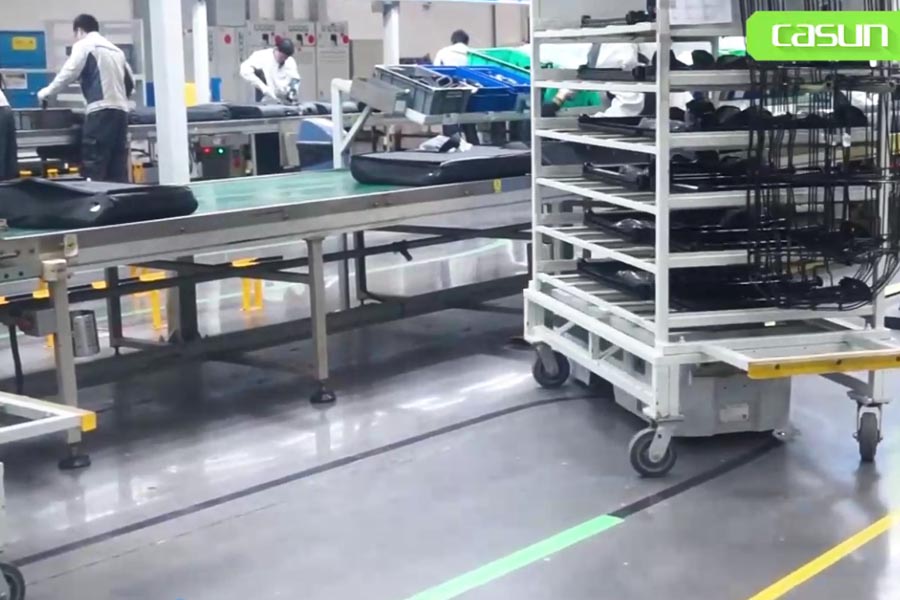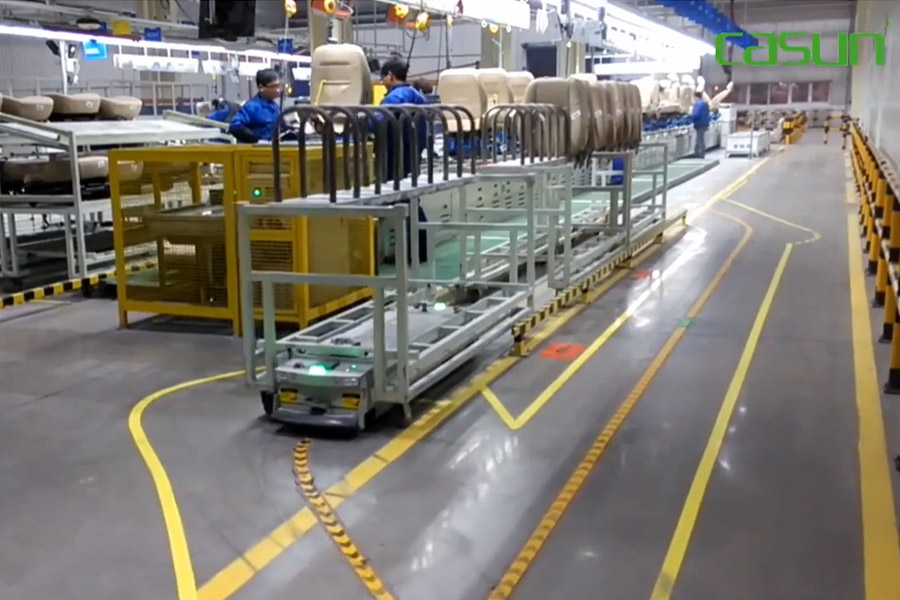Contents
Applications of AGV/AMR in the automotive logistics industry
In the traditional application department, this article will briefly summarize the four major processes of OEMs. In each process, the routine application of AGV/AMR in on-site logistics.
Stamping Workshop
In the stamping workshop, the conventional application method is to use the two-way magnetic track lurking and lurking traction AGV, lurking the traction trolley, and autonomously realize the exchange of empty idle vehicles, thereby completing the transfer and data collection of stamping parts. The advantage of this solution is that it is mature and stable, and has a significant price/performance ratio.
Welding workshop
In the welding workshop, the magnetic track lurking traction AGV is also used, which cooperates with the material truck to complete the transfer of welding parts. This requires high-precision docking between AGVs and production robots. And through the system to achieve independent call materials.
Paint shop
Although there are relatively few AGVs used in the painting workshop, the conventional solution is still the latent traction method of magnetic navigation AGVs, and the circular production line has never completed material transfer and data collection.
Assembly workshop
The final assembly workshop is the scene where the AGV queue is the most widely used and the largest in scale as a flexible production line, achieving efficient production takt time. While saving manpower, it reduces the investment in fixed assets and meets the flexible production needs of small batches and multiple batches.
Innovative applications of AGV/AMR in the automotive logistics industry
After the practical application of more than 100 projects and more than ten years of development, CASUN has now explored some innovative applications in the automotive industry. This includes technological innovation and application scenario innovation.
Applied Technology Innovation
In terms of motion navigation methods, after years of development, AGV products have become more and more mature in technology. At present, they have made great progress in speed, accuracy, navigation methods and communication methods, such as visual navigation, multi-line laser and hybrid navigation technology. The successive applications have made AGV more flexible as the carrier of smart logistics in the field. With the help of 5G communication, the large-scale application of flexible production lines has been promoted.
From the perspective of perception technology, AGV has transitioned from single intelligence to group intelligence, multi-machine collaboration, autonomous obstacle avoidance, visual recognition, autonomous deviation correction, queue following, and human-machine interaction, which further strengthens the process of unmanned factories.
From the perspective of system capabilities, cross-floor, multi-scenario, hybrid navigation, and large-scale scheduling can collect data and track the full life cycle of products while realizing material transfer, thus forming a closed data loop and facilitating management and decision-making.
Taking the CASUN intelligent control system as an example, based on the big data platform, it can be connected with various production management systems, material management systems, and warehouse management systems upward, and downward, it can be connected with various production equipment, such as manipulators, conveyor lines, and air showers. Doors, elevators, etc. At the same time, remote control can be realized through different terminals such as mobile phones, tablets, and computers. The accompanying digital simulation function can simulate the monitoring of production process planning and operation status.
Jiashun intelligent control system has 8 major advantages, BS structure is simple to operate, easy to maintain, AI intelligent algorithm realizes large-scale cluster scheduling, mixed scheduling of different navigation modes, and cross-regional scheduling. The ability of traffic management can realize rapid deployment, space optimization, and provide big data analysis to provide decision-making reference for production operations.
Application Scenario Innovation
On the basis of the above-mentioned innovative technologies, more innovative application scenarios are also derived and extended in various technological processes of OEMs. Next, I will focus on four more common and representative application scenario innovations.
The first is the door assembly line of an automobile assembly shop in South Africa. The 2-dimensional code is used to carry the lifting AGV instead of the traditional suspension line to complete the assembly action and realize flexible production, which not only improves the space utilization rate, but also reduces the input cost of fixed equipment.

